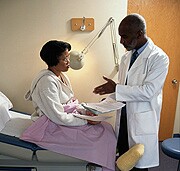
TUESDAY, March 1 (HealthDay News) — For women with uterine fibroids, three treatments have been found to relieve symptoms and result in major improvements in quality of life, according to a new study.
Up to 20 percent of women in their childbearing years develop uterine fibroids, which are benign pelvic tumors. Not all fibroids cause symptoms, but some patients experience heavy bleeding, pain and infertility, according to background information in the study, which is slated for publication in the May issue of the journal Radiology.
The researchers looked at three treatment options: hysterectomy; minimally invasive uterine artery embolization (UAE); and a noninvasive magnetic resonance-guided focused ultrasound (MRgFUS) procedure, which, unlike regular ultrasounds, which uses high doses of focused ultrasound waves guided by MR images to destroy tissue — in this case, uterine fibroids.
The study included 197 women treated for symptomatic uterine fibroids at Brigham and Women’s Hospital in Boston between 2004 and 2006. Of those patients, 62 underwent hysterectomy, 74 had the minimally invasive UAE, and 61 were treated with the MR-guided ultrasound procedure.
“Quality of life significantly increased following each of the fibroid treatment options. But patients rated the non- or minimally-invasive treatments — UAE and MRgFUS — more favorably,” lead author Dr. Fiona M. Fennessy, an assistant professor of radiology at Harvard Medical School, said in a news release from the Radiological Society of North America.
A survey of the women found that those who underwent a hysterectomy said they would wait 21 weeks in order to avoid the procedure. By contrast, women in the other two groups said they would delay their procedures by only 14 weeks, the survey found.
“Our study not only provides measures to aid in future cost-utility analysis of uterine fibroid treatments, but it may be helpful to patient and physician decision-making with regard to treatment options,” Fennessy said.
More information
The U.S. National Institute of Child Health and Human Development has more about uterine fibroids.

